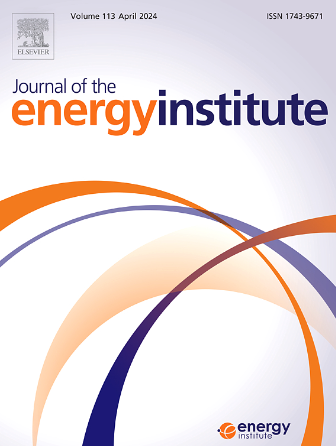基于cfd的氨柴油双燃料发动机氨燃烧及滑移行为研究
IF 5.6
2区 工程技术
Q2 ENERGY & FUELS
引用次数: 0
摘要
在现有的压缩点火发动机中,通过进气道燃油喷射策略使用零碳氨来部分取代柴油,可以减少二氧化碳的排放,但也带来了氨滑的挑战。制定有效的策略,以尽量减少氨的排放需要在燃烧过程中氨的缸内空间分布的详细知识。本研究旨在利用多维计算流体动力学(CFD)模拟,对氨柴油双燃料发动机中氨的燃烧和排放进行数值研究,包括量化每个燃烧阶段消耗的氨质量分数,并可视化其在气缸内的空间分布。CFD结果表明,在上死点附近通过低温氧化可以消耗一小部分氨,但抑制了自燃,实现了无爆燃。此外,在所研究的条件下,氨-空气混合物过于稀薄,无法支持湍流火焰的传播。因此,大部分氨是通过与柴油燃料在柴油喷雾羽流内同时燃烧而消耗的。此外,一部分未燃烧的氨在低温区域与氮氧化物(NOx)发生反应,形成一氧化二氮排放。氨在高温区域不被氧化,在低温区域脱硝,最终作为未燃烧的氨排出发动机。影响氨耗和残余氨的关键因素是氨柴油替代比,它影响柴油喷淋的发展和伴生散气的运动。较高的替代比缩短了柴油喷射持续时间,减弱了由直接喷射先导燃料动量引起的热大块气体的运动,导致柴油羽流未到达的区域更大,减少了与含氨大块混合物的相互作用,从而降低了氨的燃烧效率,使未燃烧的氨排放量增加到潜在的不可接受的水平。总体而言,旨在增强双燃料发动机氨燃烧和最小化排放的策略应侧重于使先导柴油启动的湍流火焰传播。一种有前途的方法是将氢与氨混合,这可以帮助实现低可燃性极限并改善火焰传播特性。本文章由计算机程序翻译,如有差异,请以英文原文为准。
CFD-based investigation of ammonia combustion and slip behavior in an ammonia-diesel dual-fuel engine
The use of zero-carbon ammonia to partially replace diesel in existing compression ignition engines via the port fuel injection strategy can reduce carbon dioxide emissions but introduces the challenge of ammonia slip. Developing effective strategies to minimize ammonia emissions requires detailed knowledge of the in-cylinder spatial distribution of ammonia during the combustion process. This study aims to numerically investigate ammonia combustion and emissions in an ammonia–diesel dual-fuel engine using multi-dimensional computational fluid dynamics (CFD) simulations, including quantification of the ammonia mass fraction consumed during each combustion stage and visualization of its spatial distribution within the cylinder. The CFD results indicate that a small portion of the fumigated ammonia can be consumed through low-temperature oxidation near top dead center, but self-ignition is suppressed, resulting in knocking-free combustion. In addition, under the conditions investigated, the ammonia–air mixture is too lean to support the propagation of turbulent flames. Consequently, most of the ammonia is consumed through concurrent combustion with diesel fuel within the diesel spray plume. Furthermore, a portion of the unburned ammonia reacts with nitrogen oxides (NOx) in low-temperature regions, forming nitrous oxide emissions. Ammonia that escapes oxidation in high-temperature regions and de-NOx reactions in low-temperature regions eventually exits the engine as unburned ammonia. A key factor influencing ammonia consumption and residual ammonia is the ammonia-to-diesel substitution ratio, which affects diesel spray development and the associated bulk gas motion. A higher substitution ratio shortens the diesel injection duration and weakens the motion of hot bulk gas induced by the momentum of the directly injected pilot fuel, leading to larger regions not reached by the diesel plume and reduced interaction with the ammonia-containing bulk mixture, thereby reducing ammonia combustion efficiency and increasing unburned ammonia emissions to potentially unacceptable levels. Overall, strategies aimed at enhancing ammonia combustion and minimizing emissions in dual-fuel engines should focus on enabling turbulent flame propagation initiated by pilot diesel. One promising approach is blending hydrogen with ammonia, which can help achieve the lean flammability limit and improve flame propagation characteristics.
求助全文
通过发布文献求助,成功后即可免费获取论文全文。
去求助
来源期刊

Journal of The Energy Institute
工程技术-能源与燃料
CiteScore
10.60
自引率
5.30%
发文量
166
审稿时长
16 days
期刊介绍:
The Journal of the Energy Institute provides peer reviewed coverage of original high quality research on energy, engineering and technology.The coverage is broad and the main areas of interest include:
Combustion engineering and associated technologies; process heating; power generation; engines and propulsion; emissions and environmental pollution control; clean coal technologies; carbon abatement technologies
Emissions and environmental pollution control; safety and hazards;
Clean coal technologies; carbon abatement technologies, including carbon capture and storage, CCS;
Petroleum engineering and fuel quality, including storage and transport
Alternative energy sources; biomass utilisation and biomass conversion technologies; energy from waste, incineration and recycling
Energy conversion, energy recovery and energy efficiency; space heating, fuel cells, heat pumps and cooling systems
Energy storage
The journal''s coverage reflects changes in energy technology that result from the transition to more efficient energy production and end use together with reduced carbon emission.
 求助内容:
求助内容: 应助结果提醒方式:
应助结果提醒方式:


